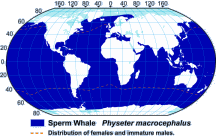Recovering Moby Dick: Sperm Whale Endangerment
by: Makenna Knell
listed as an endangered species June 2, 1970
 |
| <hickerphoto.com> |
Description
The sperm whale (Physeter macrocephalus) is the largest of the toothed whales, with males reaching approximately 18 meters in body length and females reaching 11 meters. The head accounts for 25-30% of it’s body length and houses the spermaceti organ, which is where the name “sperm whale” is derived. Contrary to popular belief, this organ does not produce sperm but rather contains a spongy, oil-filled tissue that plays a major role in a special capability called echolocation. Echolocation allows the whales to hunt in deep waters where visibility is virtually nonexistent by emitting sounds that reflect or “echo” off objects. By doing this, the whales gather information about objects and prey around them.
Sperm whales have a single S-shaped blowhole, located on the left side of the front of the head. About 2/3 back from the tip of the head lies the dorsal hump, which is followed by multiple bumps extending all the way down the dorsal ridge. As for coloration, sperm whales are predominantly black to dark brownish-grey. (I know what you’re thinking and the answer is yes- Moby Dick was in fact a sperm whale. He was actually depicted as an albino sperm whale which explains his white color!)
 |
| <enhancedlearning.com> |
Ecology
Physeter macrocephalus mainly feed on squid of the colossal and giant variety, which accounts for approximately 3% of their body weight per day. Their diet also consists of octopi, deepwater fish, and shark on occasion. Some scientists have argued that the sperm whale is the most significant vertebrate predator of its habitat.
 |
| <acsonline.org> |
Geographic &
Population Changes
These marine mammals have a world wide distribution and can be found in deep ocean waters between the latitudes of 40 degrees (S) and 50 degrees (N). Females prefer water temperatures above 15 Celsius while males are often seen in much cooler regions. However, sperm whales tend to stay out of extremely cold waters (the North and South poles), as illustrated by the map above. Even though latitudinal movements of mature males are said to be seasonal, there is very limited evidence of this and even less evidence regarding females.
Given the complexity of sperm whales’ migratory behaviors, their extremely wide geographic distribution, and their lengthy submergence times, it is particularly difficult for scientists to make population size/change estimates.
Cause of Listing and Main Threats
The predominant cause of sperm whales’ endangerment was commercial whaling, which went on for over two centuries in all parts of the world (and is still practiced illegally today). Harvesting these mammals was virtually unregulated until 1970 when quotas were introduced. Luckily, by 1981, the International Whaling Commission deemed sperm whales completely protected from commercial whaling.
Besides illegal whaling, several threats to the existence of sperm whales still persist. These remaining threats include collisions with vessels, reduced prey abundance due to climate change, contaminants and pollutants, and the effects of increasing anthropogenic ocean noise.
Recovery Plan
The goal of the U.S. Fish and Wildlife Service Recovery Plan for the sperm whale is to promote their recovery in order for them to be down listed from endangered to threatened. Once at this level, the ultimate goal is to completely de-list sperm whales.
A primary step in accomplishing this goal is to first determine population structure and discreteness. This would help start the process of estimating population size, monitoring trends in abundance, and assessing the sperm whales’ different ranges. Once these needs are met, the recovery process can move forward by conducting risk analyses, monitoring whale habitats, reducing the frequency of human-caused injury/mortality, and minimizing anthropogenic noise. The recovery plan also stresses the importance of not limiting ourselves to U.S. waters, but instead taking a multinational approach, considering the wide distribution of whales across all oceans.
 |
| <arkive.org> |
Extras!
2 divers encounter a sperm whale!
How well do you know Moby Dick? Watch this trivia video!
Sources:
http://www.cms.int/reports/small_cetaceans/data/P_macrocephalus/P_macrocephalus.htm
http://www.edgeofexistence.org/mammals/species_info.php?id=109
http://ecos.fws.gov/docs/recovery_plan/Sperm_whale_Recovery_Plan.pdf
No comments:
Post a Comment